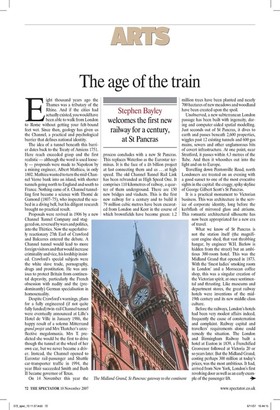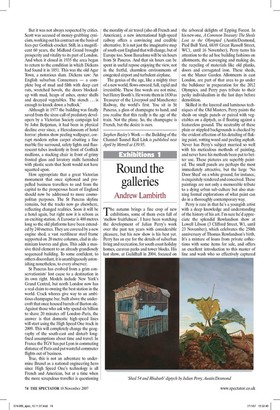The age of the train
Stephen Bayley welcomes the first new railway for a century, at St Pancras Eight thousand years ago the Thames was a tributary of the Rhine. And if the cities had actually existed, you would have been able to walk from London to Rome without getting your felt-bound feet wet. Since then, geology has given us the Channel, a practical and psychological barrier that defines national identity.
The idea of a tunnel beneath this barrier dates back to the Treaty of Amiens 1751. Here reach exceeded grasp and the first realistic — although the word is used loosely — proposals were made to Napoleon by a mining engineer, Albert Mathieu, in only 1802. Mathieu wanted to turn the mid-Channel Varne bank into an island, with shorter tunnels going north to England and south to France. Nothing came of it. Channel tunnelling first became a science with Thome de Gamond (1807-75), who inspected the seabed in a diving bell, but his diligent research brought no practical result.
Proposals were revived in 1906 by a new Channel Tunnel Company and staggered on, reversed by wars and politics, into the Thirties. Now the superlatively reactionary 27th Earl of Crawford and Balcarres entered the debate. A Channel tunnel would lead to more foreign visitors and that would increase criminality and vice, his lordship insisted. Crawford's special subjects were the white slave trade, pornography, drugs and prostitution. He was anxious to protect Britain from continental depravity, particularly the French obsession with nudity and the (predominantly) German specialisation in homosexuality.
Despite Crawford's warnings, plans for a fully engineered (if not quite fully funded) twin-rail Channel tunnel were eventually announced at Lille's Hotel de Ville in January 1986, the happy result of a solemn Mitterrand grand projet and Mrs Thatcher's unreflective megalomania. Mrs T. predicted she would be the first to drive though the tunnel at the wheel of her own car, but we never became a driver. Instead, the Chunnel opened to Eurostar rail-passenger and Shuttle car-transporter traffic in 1994, the year Blair succeeded Smith and Bush II became governor of Texas.
On 14 November this year the process concludes with a new St Pancras. This replaces Waterloo as the Eurostar terminus. It is the face of a £6 billion project at last connecting them and us ... at high speed. The old Channel Tunnel Rail Link has been rebranded as High Speed One. It comprises 110 kilometres of railway, a quarter of them underground. There are 150 new bridges and viaducts. This is the first new railway for a century and to build it 79 million cubic metres have been excavated from London and Kent in the course of which brownfields have become green: 1.2 million trees have been planted and nearly 700 hectares of new meadows and woodland have been created upon the spoil.
Unobserved, a new subterranean London passage has been built with ingenuity, daring and computer-aided spatial modelling. Just seconds out of St Pancras, it dives to earth and passes beneath 2,600 properties, wiggles past 12 existing tunnels and 600 gas mains, sewers and other unglamorous bits of covert infrastructure. At one point, near Stratford, it passes within 4.3 metres of the Tube. And then it whooshes out into the light and on to Europe.
Travelling down Pentonville Road, north Londoners are treated on an evening with a good sunset to one of the most evocative sights in the capital: the craggy, spiky skyline of George Gilbert Scott's St Pancras.
It is a practical monument to Victorian business. This was architecture in the service of corporate identity, long before the kerbflash of mirrored glass and atriums. This romantic architectural silhouette has now been appropriated for a new era of travel.
What we know of St Pancras is not the station itself (the magnificent engine shed, that vast throbbing hangar, by engineer W.H. Barlow is hidden from the street) but an ambitious 300-room hotel. This was the Midland Grand that opened in 1873. With the 'finest ladies' smoking room in London' and a Moroccan coffee shop, this was a singular creation of the Victorian spirit, at once sentimental and thrusting. Like museums and department stores, the great railway hotels were inventions of the mid19th century and its new middle-class culture.
Before the railways, London's hotels had been very modest affairs indeed, frequently the cause of consternation and complaint. Railway capital and travellers' requirements alone could remedy the situation. The London and Birmingham Railway built a hotel at Euston in 1839, a Frenchified Grosvenor followed at Victoria 20 or so years later. But the Midland Grand, costing perhaps 300 million at today's prices, was the most ambitious. It had, arrived from New York, London's first revolving door as well as an early example of the passenger lift.
But it was not always respected by critics. Scott was accused of money-grubbing cynicism, working out his contract on the basis of fees-per Gothick-crocket. Still, in a magnificent 60 years, the Midland Grand brought prosperity and vitality to its part of London. And when it closed in 1935 the area began to return to the condition in which Dickens had found it in 1851. This was the old Agar Town, a notorious slum. Dickens saw: An English suburban Connemara — a complete bog of mud and filth with deep cart ruts, wretched hovels, the doors blockedup with mud, heaps of ashes, oyster shells and decayed vegetables. The stench ... is enough to knock down a bullock.'
Although in 1977 the building was finally saved from the siren-call of predatory developers by a Victorian Society campaign led by John Betjeman, it had been in physical decline ever since, a Herculaneum of hotel horror: photos show peeling wallpaper, corrupt modern nylon carpet abutting a fine marble fire surround, safety lights and fluorescent tubes insolently in front of Gothick mullions, a stacking chair in front of grimy frosted glass and lavatory stalls furnished with plastic seats that Scott would not have squatted upon.
How appropriate that a great Victorian monument that once siphoned and propelled business travellers to and from the capital to the prosperous heart of England should now be addressed to more cosmopolitan purposes. The St Pancras skyline remains, but the tracks now go elsewhere, reflecting changed realities. Soon it will be a hotel again, but right now it is reborn as an exciting station. A Eurostar is 400 metres long so the old platforms have been extended by 240 metres. They are covered by a new engine shed, a vast rectilinear steel frame supported on 20 metre columns, clad in aluminium louvres and glass. This adds a massive third element to an already grandiosely sequenced building. To some confident, to others discordant, it is unambiguously astonishing nonetheless, to every observer.
St Pancras has evolved from a grim conservationists' lost cause to a destination in its own right. Models include New York's Grand Central, but north London now has a real claim to owning the best station in the world. Crack whores give way to an ambitious champagne bar, built above the undercroft that once housed barrels of Burton ale. Against those who ask why spend six billion to shave 20 minutes off London–Paris, the answer is that domestic high-speed lines will start using the High Speed One track in 2009. This will completely change the geography of the south-east and disturb longfixed assumptions about time and travel. In France the TGV has put Lyon in commuting distance of Paris and put wasteful commuter flights out of business.
True, this is not an adventure to undermine Brunel as a national engineering hero since High Speed One's technology is all French and American, but at a time when the more scrupulous traveller is questioning the morality of air travel (also all French and American), a new international high-speed railway offers a convincing and credible alternative. It is not just the imaginative map of south-east England that will change, but of Europe too. Soon Barcelona will be six hours from St Pancras. And that six hours can be spent in useful repose enjoying the view, not in the fretful, charmless environments of congested airport and turbulent airplane.
The genius of the age, like a mighty river of a new world, flows onward, full, rapid and irresistible. These fine words are not mine, but Henry Booth's. He wrote them in 1830 as Treasurer of the Liverpool and Manchester Railway, the world's first. You sit in St Pancras, a glass of champagne to hand, and you realise that this really is the age of the train. Not the plane. So, the champagne is French, but the desire is ours.
Stephen Bayley's Work — the Building of the Channel Tunnel Rail Link is published next April by Merrell at £39.95.






































































 Previous page
Previous page